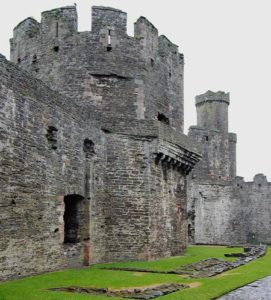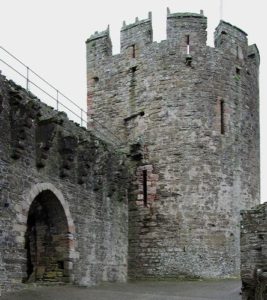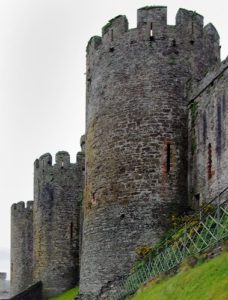I first visited Conwy Castle on a family holiday aged 15 and was bowled over by the place. Walking in through the gateway, the internal buildings stand to their full height and I could really imagine myself as Chatelaine. Fifty years on I am still bowled over by the castle each time I visit Conwy and it ranks as my all time favourite. I’m not alone in this as UNESCO considers Conwy to be one of ‘the finest examples of late 13th century and early 14th century military architecture in Europe’. It is a World Heritage site.
It is one of the most dramatic of the castles, standing on a rocky promontory overlooking the mouth of the river Conwy. It took four years to build and cost £15000. It was a state of the art fortification with massive walls and towers providing lethal fields of fire. Originally covered by white harling, it must have been an awe inspiring structure to put the fear of God (and Edward I) into the hearts of the Welsh. Power and domination hardly begin to describe it.
Edward had defeated Llywelyn ap Gruffudd, last of the Princes of Wales. With his master architect, James of St George, Edward built a series of castle around North Wales to subjugate the Welsh. The castle withstood a siege of Madog ap Llywelyn shortly after it was built. It was a temporary haven for Richard II in 1399 and was held for several months by forces loyal to Owain Glynd?r in 1401.
Following the outbreak of the English Civil War, the castle was held by forces loyal to Charles I, before surrendering to the Parliamentary armies. In the aftermath the castle was partially slighted by Parliament to prevent it being used in any further revolt, and was finally left in ruins when its remaining iron and lead was stripped and sold off.
There is a small visitor centre with ticket office and basic shop by the short stay car park. A footbridge leads across the dry moat and a path takes you along the side of the castle before climbing steeply to the barbican and steps into the castle. The original entrance would have been by a steep ramp, across a footbridge, under the portcullis and through two sets of wooden gates. Above are the remains of murder holes.
Two massive round towers guard the entrance into the outer ward. This feels quite congested as it contained the kitchen and stables (now foundations only) as well as the great hall. Below the great hall were the cellars with living accommodation above. At the far end was the garrison chapel. Behind it is the prison chapel. At the far end is the well, 91’ deep.
A stone wall separates the outer from the much smaller inner ward and would have had two wooden doors as well as a drawbridge. This contains the royal chambers and presence room. They were designed as a small palace. Not only did this provide privacy, it could also be sealed off from the rest of the castle and supplied indefinitely from the sea by the eastern gate. In fact, they were rarely used by the royal family.
At the far end is the east barbican with steps down to the water gate and a small dock. These are now masked by the later bridges.
The chapel tower could be accessed from the inner ward or from the wall walk and was just used by the royal family. On the ground floor of the chapel is a model of Conwy with castle and town walls. The chapel is on the first floor and has a small apse with the remains of wall pillars with carved capitals and a vaulted ceiling. The three lancet windows now contain attractive modern stained glass. On either side are two smaller rooms with a squint giving views of the altar. Down a side passageway is a latrine. Above it is a room with fireplace and large window seat.
Spiral staircases inside the towers give access to the wall walk around the top of eh towers. Not only does this give good views down into the castle, it also gives good views of the town walls, town and quayside.
While this still remains my favourite castle, we were not impressed by the dumbed down information boards around the site which gave little information about the castle. The free leaflet given to visitors said very little either. I came away having learnt nothing new about the castle and felt this would be the case for many visitor. While applauding the efforts of CADW to engage younger visitors I feel there is a danger of the the castle is being treated as an amusement and they are making little effort to engage the more serious visitor. This is after all a World Heritage Site. Apart from the modern stained glass window in the chapel which worked, we didn’t feel the other ‘structures’ around the site added much to our experience.
Although disabled visitors and carers are admitted free, the castle is inaccessible to anyone in a wheelchair and those with walking difficulties may also experience problems. The visitor centre is accessible but the toilets are not, as they are down a flight of stairs. There is a disabled toilet in the ladies, but it is not marked as such.
So Edward I gets 5*, CADW considerably less.










